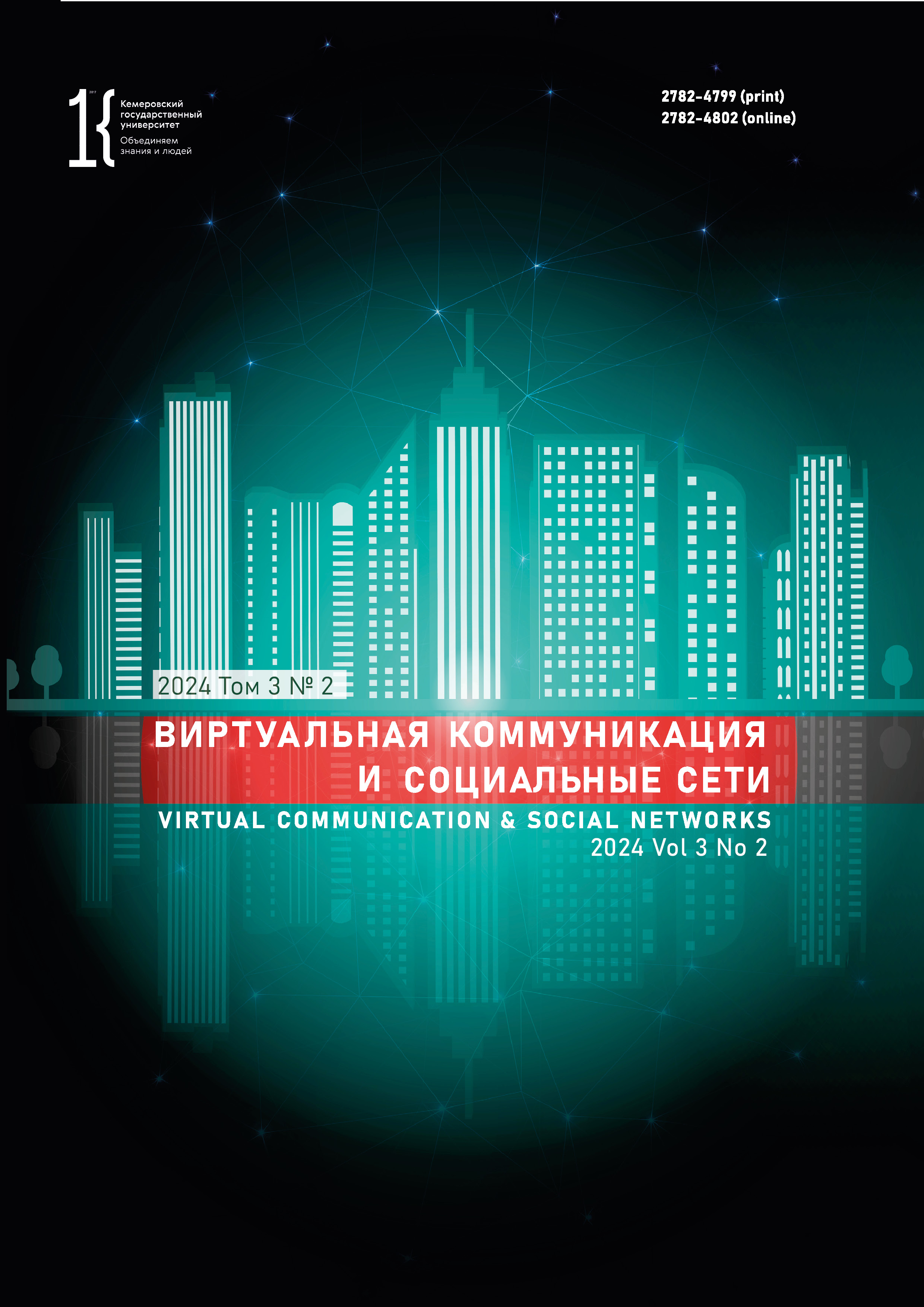Permskiy gosudarstvennyy nacional'nyy issledovatel'skiy universitet
Minsk, Belarus
Perm, Perm, Russian Federation
A clear and unambiguous rendering of spatial relations is the key cognitive function of communication. Spatial relationships reflect the categories and experience shared by all people. The paper introduces the first-of-its-kind attempt to describe the dual spatial orientation of the speaker in virtual reality as depending on two factors: the communicative situation and the gender. Dual spatial orientation combines egocentric, allocentric, or geocentric orientations and their varieties. The combination depends on various factors. The experiment in virtual environment involved 24 informants and five scenarios (scenes) with different communicative parameters. It yielded 725 responses with combinations of double orientations, which went through the IS Semograph. The combination of allocentric and geocentric orientation domineered; the extra-linguistic gender factor and some communicative parameters affected the frequency of combinations of dual spatial orientation. The core of the speaker’s dual spatial orientation in virtual reality combined allocentric and geocentric orientations to the topos of GE \ T + AL and AL + GE \ T.
virtual reality, spatial orientation, deixis, gender, communication
1. Taleski A. Speaker's behavior in virtual reality (methodology of the experiment and description of preliminary results). Perm University Herald. Russian and Foreign Philology, 2020, 12(4): 54–67. (In Russ.) https://doi.org/10.17072/2073-6681-2020-4-54-67
2. Berthele R. Ort und Weg. Berlin: Walter de Gruyter, 2006, 305.
3. Bohil C., Owen Ch. B., Jeong E. J., Alicea B., Biocca F. Virtual reality and presence. 21st century communication: A reference handbook, ed. Eadie W. F. Newbury park: Sage, 2009, 534–544. http://dx.doi.org/10.4135/9781412964005
4. Bryant D. J. A spatial representation system in humans. Psycholoquy, 1992, 3(16). URL: https://www.cogsci.ecs.soton.ac.uk/cgi/psyc/newpsy?3.16 (accessed 23 Apr 2024).
5. Byagowi A., Moussavi Z. Design of a Virtual Reality Navigational (VRN) experiment for assessment of egocentric spatial cognition. 2012 Annual International Conference of the IEEE Engineering in Medicine and Biology Society: Proc. Conf., San Diego, 1 Sep 2012. San Diego: IEEE, 2012, 4812–4815. https://doi.org/10.1109/EMBC.2012.6347070
6. Castronovo F., Nikolic D., Liu Y., Messner J. An evaluation of immersive virtual reality systems for design reviews. 13th International Conference on Construction Applications of Virtual Reality: Proc. Conf., London, 30–31 Oct 2013. London: UK, 2013, 22–29.
7. Creem-Regehr S. H., Stefanucci J. K., Thompson W. B. Perceiving absolute scale in virtual environments: How theory and application have mutually informed the role of body-based perception. Psychology of Learning and Motivation, 2015, 62: 195–224. https://doi.org/10.1016/bs.plm.2014.09.006
8. Fox J., Arena D., Bailenson J. N. Virtual Reality: A survival guide for the social scientist. Journal of Media Psychology, 2009, 21(3): 95–113. https://doi.org/10.1027/1864-1105.21.3.95
9. Gramann K. Embodiment of spatial reference frames and individual differences in reference frame proclivity. Spatial Cognition & Computation: An Interdisciplinary Journal, 2013, 13(1): 1–25. https://doi.org/10.1080/13875868.2011.589038
10. Interrante V., Ries B., Anderson L. Distance perception in immersive virtual environments, revisited. IEEE Virtual Reality Conference: Proc. Conf., Alexandria, 25–29 Mar 2006. Alexandria: IEEE, 2006, 3–10. https://doi.org/10.1109/VR.2006.52
11. Jones J. A., Hopper J. E., Bolas M. T., Krum D. M. Orientation perception in real and virtual environments. IEEE Transactions on Visualization and Computer Graphics, 2019, 25(5): 2050–2060. https://doi.org/10.1109/TVCG.2019.2898798
12. Keshner E. A., Kenyon R. V. Postural and spatial orientation driven by virtual reality. Studies in Health Technology and Informatics, 2009, 145: 209–228. https://doi.org/10.3233/978-1-60750-018-6-209
13. Kim J. J.-J., McManus M. E., Harris L. R. Body orientation affects the perceived size of objects. Perception, 2022, 51(1): 25–36. https://doi.org/10.1177/03010066211065673
14. Klatzky R. L. Allocentric and egocentric spatial representations: Definitions, distinctions, and interconnections. Lecture Notes in Artificial Intelligence, 1998, 1: 1–17. https://doi.org/10.1007/3-540-69342-4_1
15. Levinson S. C. Frames of reference and Molyneux’s question: Crosslinguistic evidence. Language and Space, 1996, 109–169. https://doi.org/10.7551/mitpress/4107.003.0006
16. Levinson S. C. Space in language and cognition: Explorations in cognitive diversity. Cambridge: Cambridge University Press, 2003, 414.
17. Levinson S. C. Vision, shape, and linguistic description: Tzeltal body-part terminology and object description. Linguistics, 1994, 32(4-5): 791–855. https://doi.org/10.1515/ling.1994.32.4-5.791
18. Mohler B. J., Creem-Regehr S. H., Thompson W. B. The influence of feedback on egocentric distance judgments in real and virtual environments. APGV '06: Proceedings of the 3rd symposium on Applied perception in graphics and visualization: Proc. Symp., Boston, 28–29 Jul 2006. NY: Association for Computing Machinery, 2006, 9–14. https://doi.org/10.1145/1140491.1140493
19. Moon H.-J., Wu H.-P., Falco E., Blanke O. Physical body orientation impacts virtual navigation experience and performance. Eneuro, 2023, 10(11): 1–12. https://doi.org/10.1523/ENEURO.0218-23.2023
20. Morganti F., Stefanini S., Riva G. From allo- to egocentr ic spatial ability in early Alzheimer’s disease: A study with virtual reality spatial tasks. Cognitive Neuroscience, 2013, 4(3-4): 171–180. https://doi.org/10.1080/17588928.2013.854762
21. Park C., Jang K. Investigation of visual self-representation for a Walking-in-Place navigation system in virtual reality. IEEE Conference on Virtual Reality and 3D User Interfaces (VR): Proc. Conf., Osaka, 23–27 Mar 2019. Osaka: IEEE, 2019, 1114–1115. https://doi.org/10.1109/VR.2019.8798345
22. Pastel S., Chen C. H., Bürger D., Naujoks M., Martin L. F., Petri K., Witte K. Spatial orientation in virtual environment compared to real-world. Journal of Motor Behavior, 2020, 53(6): 693–706. https://doi.org/10.1080/00222895.2020.1843390
23. Peeters D. Virtual reality: A game-changing method for the language sciences. Psychonomic Bulletin & Review, 2019, 26(3): 894–900. https://doi.org/10.3758/s13423-019-01571-3
24. Phillips L., Interrante V., Kaeding M., Ries B., Anderson L. Correlations between physiological response, gait, personality, and presence in immersive virtual environments. Presence, 2012, 21(2): 119–141. https://doi.org/10.1162/PRES_a_00100
25. Shelton A. L., McNamara T. P. Multiple views of spatial memory. Psychonomic Bulletin & Review, 1997, 4(1): 102–106.
26. Wartenberg F., May M., Peruch P. Spatial orientation in virtual environments: Background considerations and experiments. Spatial Cognition: An interdisciplinary approach to representing and processing spatial knowledge, eds. Freksa C., Habel C., Wender K. F. Berlin; Heidelberg; New York; Barcelona; Budapest; Hong Kong; London; Milan; Paris; Santa Clara; Singapore; Tokyo: Springer, 1998, 1404: 469–489. https://doi.org/10.1007/3-540-69342-4_22
27. Wolbers T., Hegarty M. What determines our navigational abilities? Trends in Cognitive Science, 2010, 14(3): 138–146. https://doi.org/10.1016/j.tics.2010.01.001


















